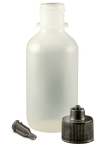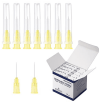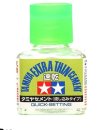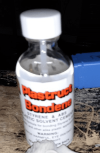You are using an out of date browser. It may not display this or other websites correctly.
You should upgrade or use an alternative browser.
You should upgrade or use an alternative browser.
Plastic Model Glue
- Thread starter TJBegin
- Start date
urumomo
Well-Known Member
- Joined
- Mar 18, 2013
- Messages
- 6,818
What do you mean by quick set glue ?
CA ?
I think the best cement for the majority of styrene construction is the low viscosity solvent cements applied vis capillary action .
Butyl acetate , ethyl acetate , MEK / butanone .
Examples being Tamiya Extra Thin and the like .
CA ?
I think the best cement for the majority of styrene construction is the low viscosity solvent cements applied vis capillary action .
Butyl acetate , ethyl acetate , MEK / butanone .
Examples being Tamiya Extra Thin and the like .
Pantherman
Well-Known Member
- Joined
- Feb 10, 2022
- Messages
- 3,312
Hi, I mainly use tamiya extra thin and for something a little bit quicker to set I use tamiya extra thin quick set. It stinks but does the job.Hello fellow plastic modelers:
I could use some advise. I tend to use fast-setting glues with model kits but have mixed results. Sometimes they work, sometimes they just don't hold. Any recommendations on quick-set glue that is dependable?
Pantherman
Attachments
BTrekker
Member
- Joined
- Jul 10, 2022
- Messages
- 44
the Baron
Ich bin ja, Herr, in Deiner Macht
- Joined
- May 12, 2009
- Messages
- 2,144
I had the same thought as Momo-what kind of glue did you mean, glue for styrene, CA glue, etc?
I use glues made for styrene with styrene, and not CA or 2-part epoxies, because I want the weld bond that such glues provide. I always used Testor's tube glue, both when I was a kid, and when I got back into building models (geez, that's now about 25 years ago!).
When I got back into the hobby, I learned about liquid styrene cements and starting using them, too. Like BTrekker, I first used Plastruct's products-Bondene and Weldene-to get used to working with liquid cements.
Like Momo noted, you get capillary action with liquid cements, and for me, building airplanes, I find that works very well, flowing the cement into seams between fuselage halves, or wing tops and bottoms. And it makes it easy to use the "beading" technique, to help reduce visible seams. As the glue flows into the seam, you apply a little pressure, till a bead of melted plastic is extruded along the seam. When that cures, you can scrape it away and reduce the amount of filling and sanding.
From Plastruct's liquid cements, I moved to using Testor's liquid cement in the little black bottle shaped like a quarter wedge, with the long applicator tip. And then I started using Tamiya's Extra Thin. I still use Testor's tube glue, too, for pieces where I want a little time to make adjustments.
I use CA glue and 2-part epoxies for bonding unlike materials, like metal or resin to styrene, or resin to resin or metal, and metal to metal.
I use glues made for styrene with styrene, and not CA or 2-part epoxies, because I want the weld bond that such glues provide. I always used Testor's tube glue, both when I was a kid, and when I got back into building models (geez, that's now about 25 years ago!).
When I got back into the hobby, I learned about liquid styrene cements and starting using them, too. Like BTrekker, I first used Plastruct's products-Bondene and Weldene-to get used to working with liquid cements.
Like Momo noted, you get capillary action with liquid cements, and for me, building airplanes, I find that works very well, flowing the cement into seams between fuselage halves, or wing tops and bottoms. And it makes it easy to use the "beading" technique, to help reduce visible seams. As the glue flows into the seam, you apply a little pressure, till a bead of melted plastic is extruded along the seam. When that cures, you can scrape it away and reduce the amount of filling and sanding.
From Plastruct's liquid cements, I moved to using Testor's liquid cement in the little black bottle shaped like a quarter wedge, with the long applicator tip. And then I started using Tamiya's Extra Thin. I still use Testor's tube glue, too, for pieces where I want a little time to make adjustments.
I use CA glue and 2-part epoxies for bonding unlike materials, like metal or resin to styrene, or resin to resin or metal, and metal to metal.
Wow. You guys are a wealth of knowledge. Lots of good advise but please help me understand some of what I read: (1) what is CA? (2) the plastic models I'm referring to are like the Revell plastic model kits, if that helps or changes any of your answers.
urumomo
Well-Known Member
- Joined
- Mar 18, 2013
- Messages
- 6,818
CA = cyanoacrylate / " super glue "
Capillary action allows you to hold the 2 pieces together and just touch the joint with the solvent cement applicator and the " glue " will flow into the tiny gap between the parts and complete the weld .
https://en.wikipedia.org/wiki/Capillary_action
Capillary action allows you to hold the 2 pieces together and just touch the joint with the solvent cement applicator and the " glue " will flow into the tiny gap between the parts and complete the weld .
https://en.wikipedia.org/wiki/Capillary_action
Pantherman
Well-Known Member
- Joined
- Feb 10, 2022
- Messages
- 3,312
I wouldn't want to bet that there is something that you do not know oh master of modeling knowledge.CA = cyanoacrylate / " super glue "
Capillary action allows you to hold the 2 pieces together and just touch the joint with the solvent cement applicator and the " glue " will flow into the tiny gap between the parts and complete the weld .
https://en.wikipedia.org/wiki/Capillary_action
Pantherman
BTrekker
Member
- Joined
- Jul 10, 2022
- Messages
- 44
Tamiya Super Thin or Plastruct Bondene - both are water-thin and will get 'sucked' into the seam through capillary action...just like @urumomo said.(2) the plastic models I'm referring to are like the Revell plastic model kits, if that helps or changes any of your answers.
With my Bondene, I use #00 paint brushes for this - the brush included is way too big.
urumomo
Well-Known Member
- Joined
- Mar 18, 2013
- Messages
- 6,818
PffftI wouldn't want to bet that there is something that you do not know oh master of modeling knowledge.
Pantherman
the Baron
Ich bin ja, Herr, in Deiner Macht
- Joined
- May 12, 2009
- Messages
- 2,144
A lifetime (or nearly a lifetime) of experience, my friend! Glad to share it, and hope it's useful.Wow. You guys are a wealth of knowledge. Lots of good advise but please help me understand some of what I read: (1) what is CA? (2) the plastic models I'm referring to are like the Revell plastic model kits, if that helps or changes any of your answers.
As far as the Revell kits go, those are made of styrene plastic, and the glues we mentioned, like Testor's tube and liquid glues, Tamiya's Extra Thin, Plastruct's liquid glues, are all formulated to be used with styrene kits. Most injection-molded plastic kits are styrene, as far as I know.
The compounds Momo mentioned are active ingredients in most styrene cements, one or another, if I am not mistaken. I think you can buy MEK (methyl ethyl ketone, I think that is) in quantity, too, though I have only read others comment about doing so. I have not done so myself.
BTrekker
Member
- Joined
- Jul 10, 2022
- Messages
- 44
For more reasons than just 'it'll disolve the plastic instead of welding it'.Stay away from MEK ( butanone )

It's highly hazardous to just breath the fumes and get on skin - when we used it at work to remove contact cement from steel tanks, we did it in the loading bay, doors open, fans running with gloves and breathing masks on...even if it was 0f outside - we'd just put on our jackets.
Thanks, guys. Now you've made me curious to try something you mentioned: capillary action. I understand now how it works but how do you apply the glue. You hold the pieces together, apply the glue to the seam and capillary action draws the thin glue into the seam. But, do you apply the glue on the exterior seam? If so, how do you prevent it from leaving glue blotches on the surface?
BTrekker
Member
- Joined
- Jul 10, 2022
- Messages
- 44
Several methodsBut, do you apply the glue on the exterior seam? If so, how do you prevent it from leaving glue blotches on the surface?
The Tamiya has a very fine brush included.
I use #00 paint brushes with my Bondene as the included brush is way too big for fine work.
A capillary action applicator - basically a very narrow tube that draws up the glue when you dip it in the bottle, then leaves a thin line on the surface when you touch it to the model seam.
Another thing I use is a small squeeze bottle with a 30gauge hypodermic needle...there's squeeze bottles with Luer-Lock ends and you get needles that are Luer-Lock compatible.


Similar threads
Latest posts
-
-
-
-
-
-
ready to throw away the testors "orange tube"
- Latest: scalebuilderchad
-
-


